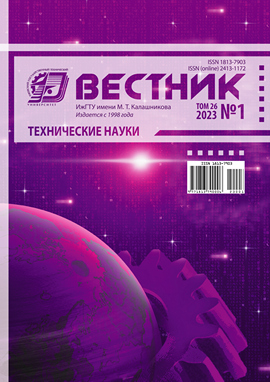Параметрическая идентификация матричной модели согласующего антенного устройства
DOI:
https://doi.org/10.22213/2413-1172-2023-1-71-83Ключевые слова:
векторный анализатор цепей, идентифицируемость, планирование эксперимента, параметрическая идентификация, матричная структура, модель, дискретный контурАннотация
Современные тенденции развития радиосвязи в диапазоне ДКМВ предусматривают улучшение управляемости и увеличение скорости перестройки согласующих антенных устройств (САУ). Необходимость управления процессом настройки с помощью микроконтроллера по результатам измерения входного импеданса антенны в режиме online требует повышения точности моделирования трансформирующих свойств этих устройств и последующих расчетов по выработке команд регулирования дискретными органами согласования. Чем достовернее данные в памяти микроконтроллера будут характеризовать реальные свойства органов согласования устройства, тем лучше будет регулирование ими. По результатам натурного эксперимента рассмотрены вопросы параметрической идентификации ранее предложенной концептуальной матричной модели дискретного силового контура широкодиапазонного САУ. Ввиду сложности технологического моделирования трансформирующих свойств контуров стоит задача повышения точности его численных результатов для каждого устройства. При найденном множестве решений для модели с выбранной структурой и значительном количестве неизвестных параметров ее идентификация по экстремуму целевой функции не представляется возможной. Соответственно, проведен анализ априорной идентифицируемости (теоретической, с однозначным определением параметров) на основе качественного исследования структуры модели и схемы «идеального» эксперимента (с детерминированностью всех безошибочно измеряемых величин). Идентифицируемость предложенной модели силового контура подтверждена. Описаны варианты проведения эксперимента, алгоритм обработки его результатов, а также способы получения их гарантированного качества с помощью векторного анализатора цепей за известное время при заданных затратах. Критерием оценки соответствия модели реальному силовому контуру определена мера количества ее ошибок после измерений комплексных коэффициентов на наборе частот. Обработка результатов по методу наименьших квадратов с интерполяцией для всего частотного диапазона уменьшает погрешности и трудоемкость эксперимента. Моделирование 9-разрядного индуктивного органа согласования устройства подтвердило корректность и эффективность матричного описания трансформирующих свойств широкодиапазонного САУ и других представленных решений, а также возможность полной автоматизации проведения данного эксперимента.Библиографические ссылки
Зайдель А. Н. Погрешности измерений физических величин. Л.: Наука, 1985. 112 с.
Тейлор Дж. Введение в теорию ошибок: пер. с англ. 1985. 272 с.
Джоэль П. Дансмор. Настольная книга инженера. Измерения параметров СВЧ-устройств с использованием передовых методик векторного анализа цепей: пер. с англ. М.: Техносфера, 2019. 736 с. (Мир радиоэлектроники).
Patent USA № 2632058. Pulse code communication. Frank Gray. New York, USA Bell Telephone Laboratories, Incorporated. 1953-03-17.
Хибель М. Основы векторного анализа цепей. Изд. 2-е, испр. и доп. М.: Изд. дом МЭИ, 2019. 500 с.
Жохов К. С., Димаки А. В., Синогин М. В. Аппаратно-программный комплекс для автоматизированного измерения параметров усилителей мощности // Электроника и микроэлектроника СВЧ. 2022. Т. 1. С. 15-20.
Широкополосная радиолокационная установка на базе векторного анализатора цепей / С. И. Моряков, С. М. Нестеров, П. Н. Скоков, И. А. Скородумов // Труды военно-космической академии имени А. Ф. Можайского. 2019. № 670. С. 164-168.
Авдеенко Т. В. Проблемы параметрической идентификации в математическом моделировании процессов // Вестник Московского университета С. Ю. Витте. Новые технологии. 2019. № 1 (4). С. 115-124.
Яковис Л. М. Адаптивная идентификация объектов управления в системах с типовыми регуляторами // Материалы конференции "Информационные технологии в управлении" (Санкт-Петербург, ЦНИИ "Электроприбор", 2020 г.). С. 246-249.
Эйкхофф П. Основы идентификации систем управления. Оценивание параметров и состояния. М.: Мир, 1975. 681 с.
Фельдштейн А. Л., Явич Л. Р. Синтез четырехполюсников и восьмиполюсников на СВЧ. 2-е издание. М.: Связь, 1971. 388 с.
Никольский В. В., Никольская Е. И. Декомпозиционный подход к задачам электродинамики. М.: Наука, 1983. 304 с.
Didenko D.M. Vector Network Analyzer. Languages in professional communication, 2021, pp. 407-414.
Саввин А. А., Губа В. Г., Ладур А. А. Анализ точности измерений параметров электронных компонентов печатных плат // 27-я Международная конференция "СВЧ-техника и коммуникационные технологии" (Севастополь, КрыМиКо-2017): в 9 т. 2017. Т. 5. С. 1274-1280.
Харитонов Е. Ю., Вышлов В. А. Метод калибровки однопортового векторного анализатора цепей и определения параметров калибровочных мер на основе анализа откликов во временной области // Вестник метролога. 2020. № 4. С. 9-16.
Патент RU 148205 U1, класс H03H 1/00. Антенно-согласующее устройство с измерительно-вычислительным методом настройки / Калинин А. Л., Смаль А. А. 2014.
Патент RU 65701 U1, класс H04B 1/04. Устройство согласования радиопередатчика с антенной / В. Н. Елисеев, Ю. Г. Передин, В. Л. Муравченко, Н. В. Хотулева. 2007.
Патент RU 142638 U1, класс H03H 1/00. Антенно-согласующее устройство с повышенным быстродействием / Бурова А. А., Калинин А. Л., Леппа В. Р. 2014.
Патент RU 181435 U1, класс H03H 1/00. Антенно-согласующее устройство с вычислительным алгоритмом настройки / А. Л. Калинин, И. С. Забродин, Т. Е. Забродина, А. А. Смаль, Л. Н. Петрова. 2018.
Патент RU 114244 U1, класс H03H 1/00. Антенно-согласующее устройство / А. А. Смаль, А. Л. Калинин. 2014.
Загрузки
Опубликован
Как цитировать
Выпуск
Раздел
Лицензия
Copyright (c) 2023 Вестник ИжГТУ имени М.Т. Калашникова

Это произведение доступно по лицензии Creative Commons «Attribution» («Атрибуция») 4.0 Всемирная.


